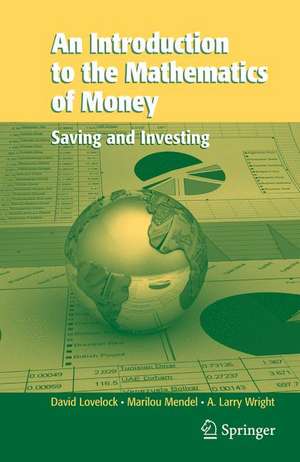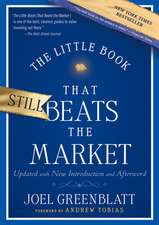An Introduction to the Mathematics of Money: Saving and Investing
Autor David Lovelock, Marilou Mendel, Arthur L. Wrighten Limba Engleză Hardback – 24 oct 2006
| Toate formatele și edițiile | Preț | Express |
|---|---|---|
| Paperback (1) | 488.51 lei 6-8 săpt. | |
| Springer – 18 oct 2010 | 488.51 lei 6-8 săpt. | |
| Hardback (1) | 588.69 lei 6-8 săpt. | |
| Springer – 24 oct 2006 | 588.69 lei 6-8 săpt. |
Preț: 588.69 lei
Preț vechi: 692.58 lei
-15% Nou
Puncte Express: 883
Preț estimativ în valută:
112.65€ • 120.46$ • 93.92£
112.65€ • 120.46$ • 93.92£
Carte tipărită la comandă
Livrare economică 17 aprilie-01 mai
Preluare comenzi: 021 569.72.76
Specificații
ISBN-13: 9780387344324
ISBN-10: 0387344322
Pagini: 294
Ilustrații: XII, 300 p. 67 illus.
Dimensiuni: 155 x 235 x 19 mm
Greutate: 0.55 kg
Ediția:2007
Editura: Springer
Colecția Springer
Locul publicării:New York, NY, United States
ISBN-10: 0387344322
Pagini: 294
Ilustrații: XII, 300 p. 67 illus.
Dimensiuni: 155 x 235 x 19 mm
Greutate: 0.55 kg
Ediția:2007
Editura: Springer
Colecția Springer
Locul publicării:New York, NY, United States
Public țintă
GraduateCuprins
Simple Interest.- Compound Interest.- Infiation and Taxes.- Annuities.- Loans and Risks.- Amortization.- Credit Cards.- Bonds.- Stocks and Stock Markets.- Stock Market Indexes, Pricing, and Risk.- Options.
Recenzii
From the reviews:
"This book is written for students without assuming a background or any experience in investing. A basic knowledge in real analysis is necessary. The student is introduced to elements of saving and investing that are of lifelong practical use. These includes saving, checking accounts, certificates of deposit, student loan, credit cards, mortgages, buying and selling bonds of stocks. The authors follow a systematic pattern with a variety of examples and exercises. … suitable for fundamental courses in mathematics, investing, banking, financial engineering, and related topics." (Klaus Ehemann, Zentralblatt MATH, Vol. 1114 (16), 2007)
"This book is designed to serve as an undergraduate text on the fundamentals of personal savings and investing. … The book includes an appendix that covers basic concepts and techniques in probability and mathematical statistics. … follows a different philosophy; it allows the results and examples to speak for themselves. … it serves as a valuable resource for attaining savings, investment, and retirement goals." (Joseph Cavanaugh, The American Statistician, Vol. 62 (2), May, 2008)
"This book is written for students without assuming a background or any experience in investing. A basic knowledge in real analysis is necessary. The student is introduced to elements of saving and investing that are of lifelong practical use. These includes saving, checking accounts, certificates of deposit, student loan, credit cards, mortgages, buying and selling bonds of stocks. The authors follow a systematic pattern with a variety of examples and exercises. … suitable for fundamental courses in mathematics, investing, banking, financial engineering, and related topics." (Klaus Ehemann, Zentralblatt MATH, Vol. 1114 (16), 2007)
"This book is designed to serve as an undergraduate text on the fundamentals of personal savings and investing. … The book includes an appendix that covers basic concepts and techniques in probability and mathematical statistics. … follows a different philosophy; it allows the results and examples to speak for themselves. … it serves as a valuable resource for attaining savings, investment, and retirement goals." (Joseph Cavanaugh, The American Statistician, Vol. 62 (2), May, 2008)
Textul de pe ultima copertă
This is an undergraduate textbook on the basic aspects of personal savings and investing with a balanced mix of mathematical rigor and economic intuition. It uses routine financial calculations as the motivation and basis for tools of elementary real analysis rather than taking the latter as given. Proofs using induction, recurrence relations and proofs by contradiction are covered. Inequalities such as the Arithmetic-Geometric Mean Inequality and the Cauchy-Schwarz Inequality are used. Basic topics in probability and statistics are presented. The student is introduced to elements of saving and investing that are of life-long practical use. These include savings and checking accounts, certificates of deposit, student loans, credit cards, mortgages, buying and selling bonds, and buying and selling stocks.
The book is self contained and accessible. The authors follow a systematic pattern for each chapter including a variety of examples and exercises ensuring that the student deals with realities, rather than theoretical idealizations. It is suitable for courses in mathematics, investing, banking, financial engineering, and related topics.
The book is self contained and accessible. The authors follow a systematic pattern for each chapter including a variety of examples and exercises ensuring that the student deals with realities, rather than theoretical idealizations. It is suitable for courses in mathematics, investing, banking, financial engineering, and related topics.
Caracteristici
Many illustrations included throughout the text Exercises at the end of each chapter An only undergraduate text providing an introduction to the mathematics of savings Includes supplementary material: sn.pub/extras















